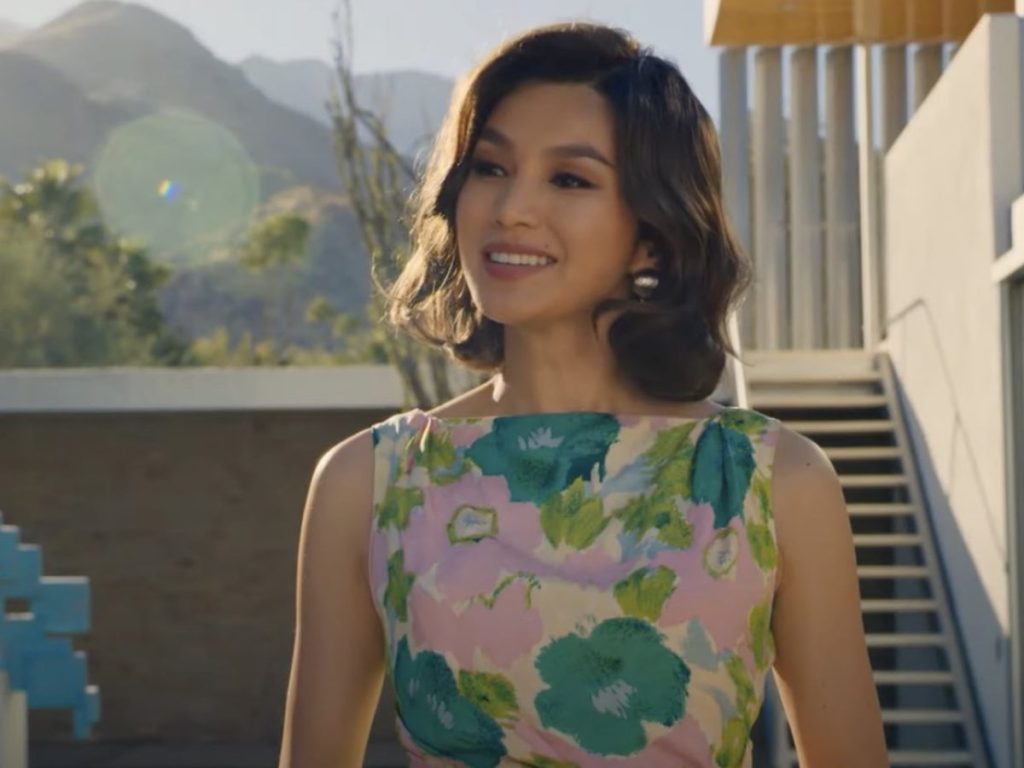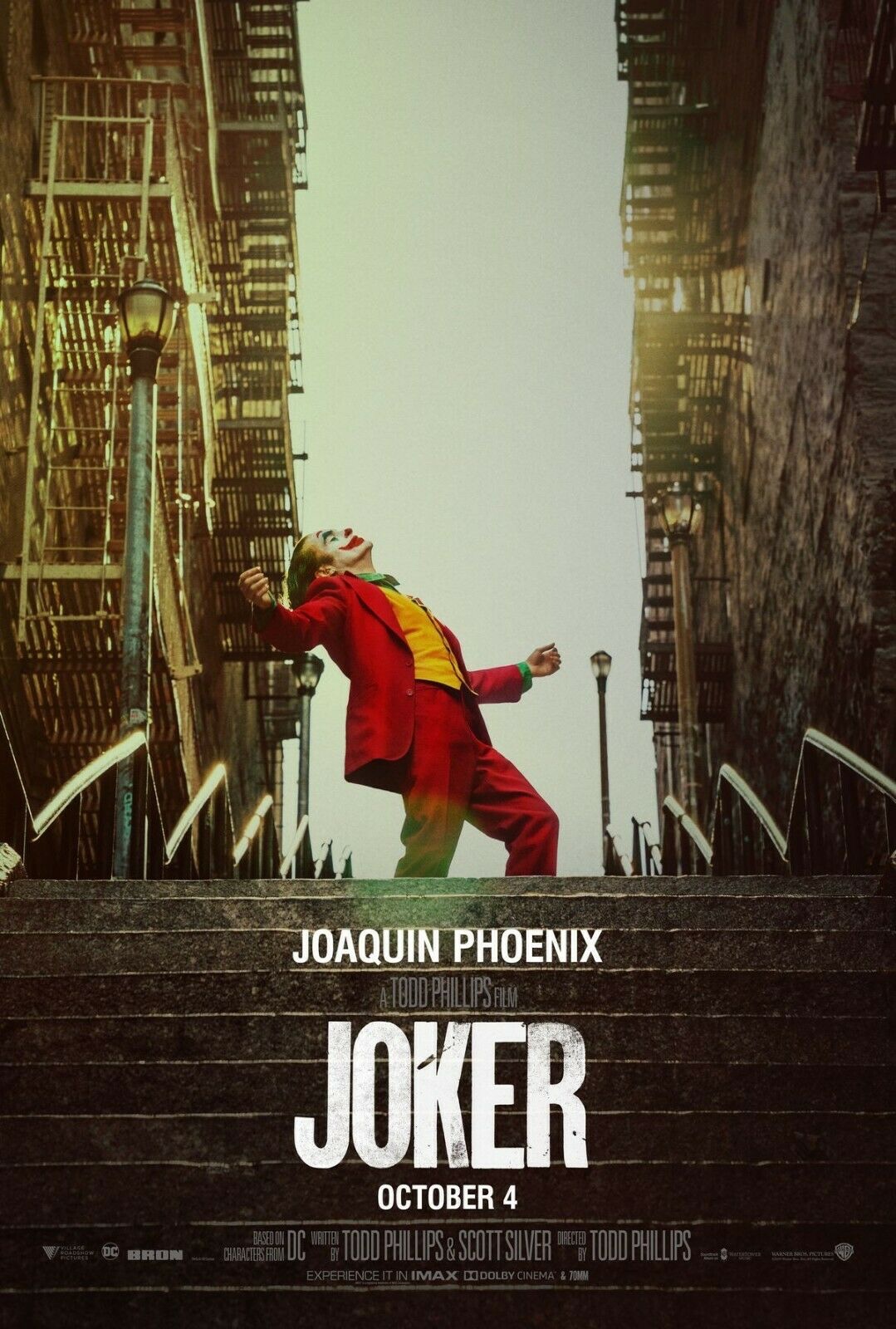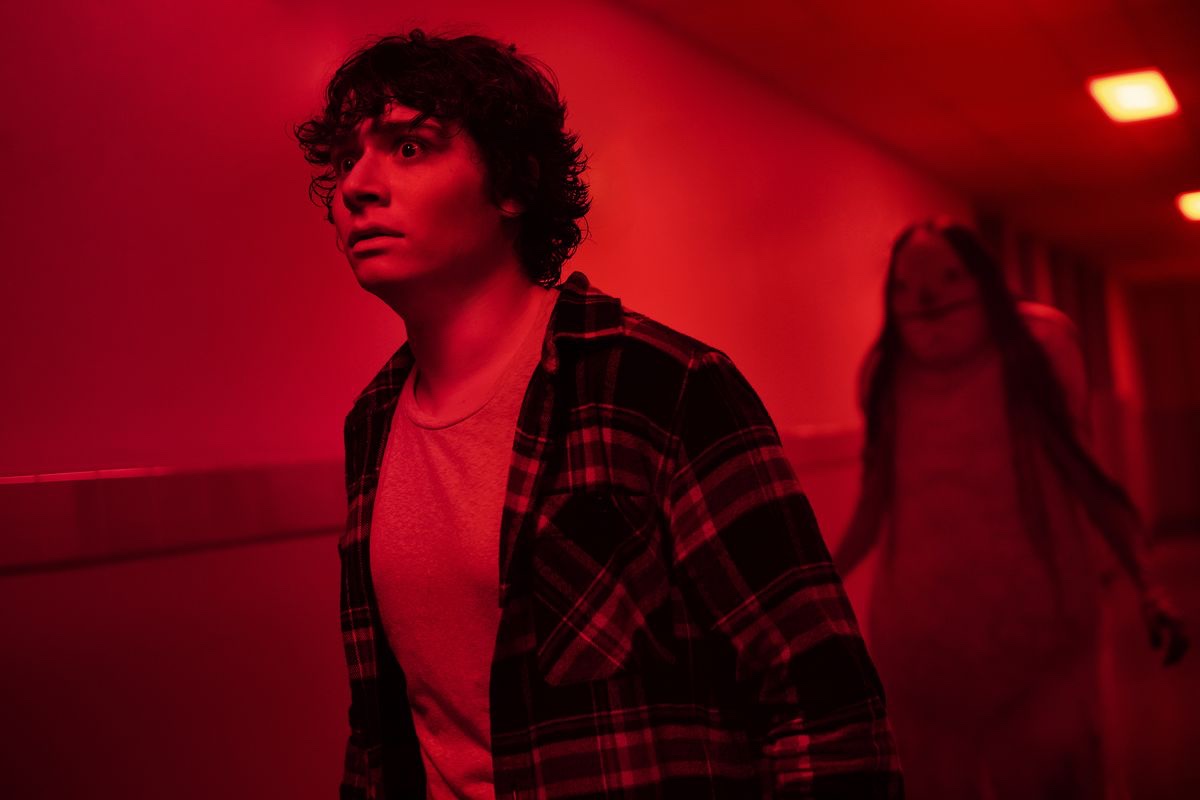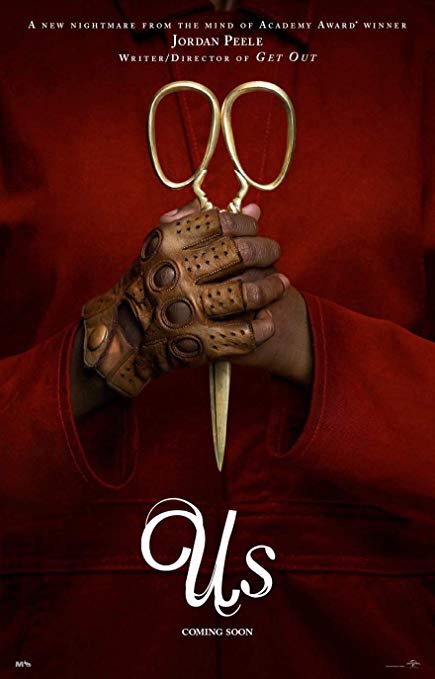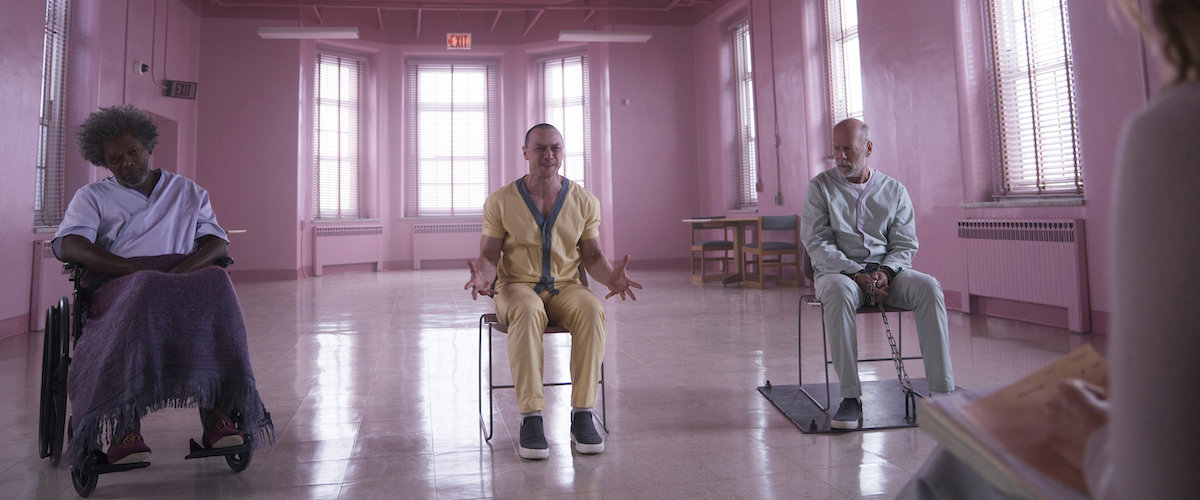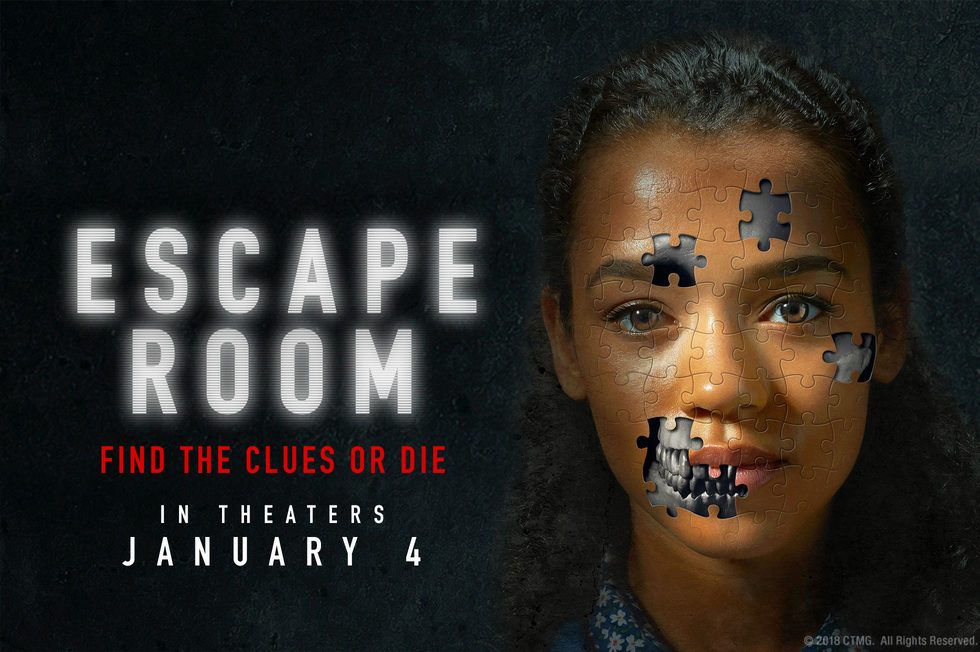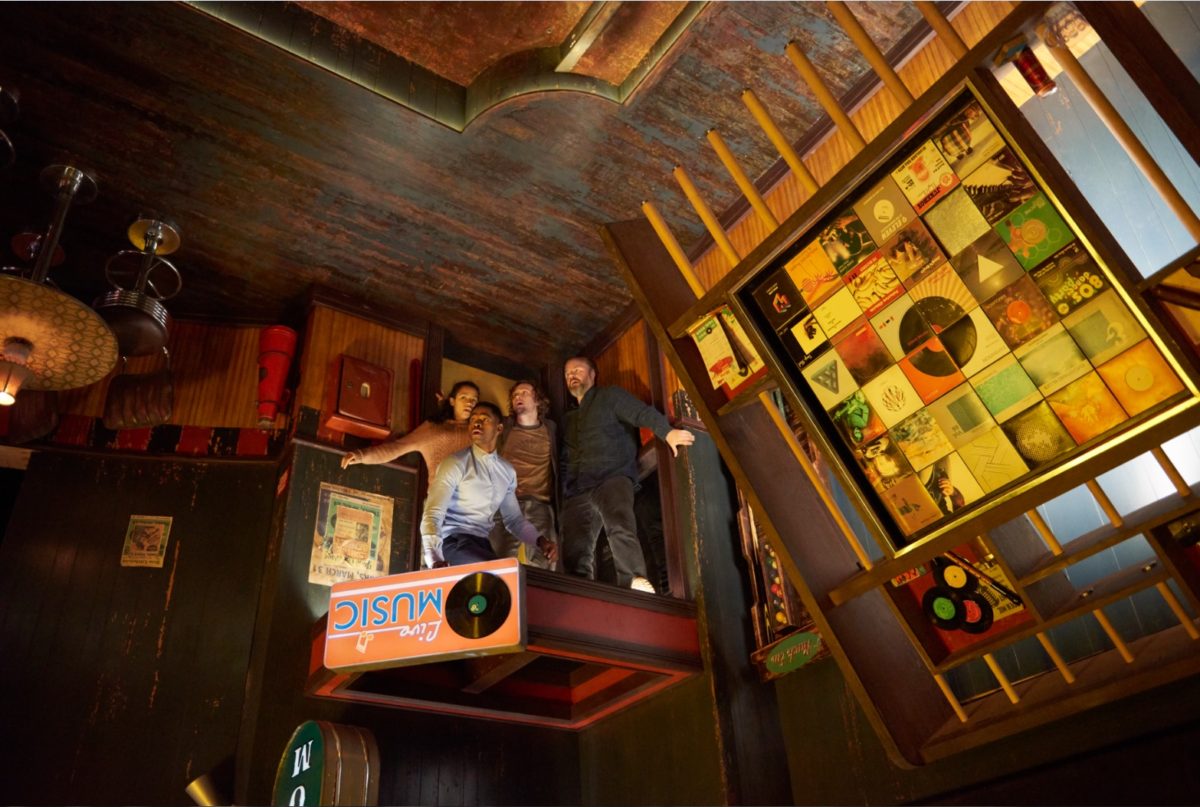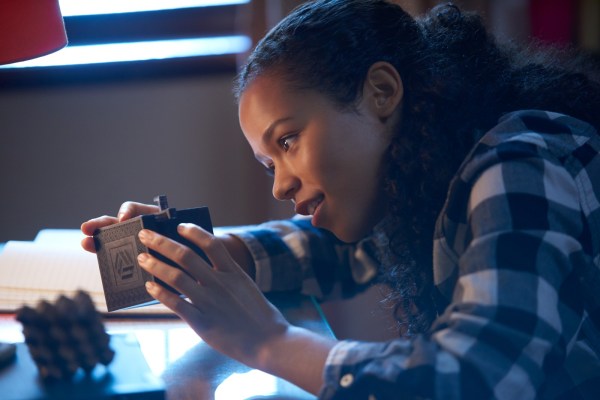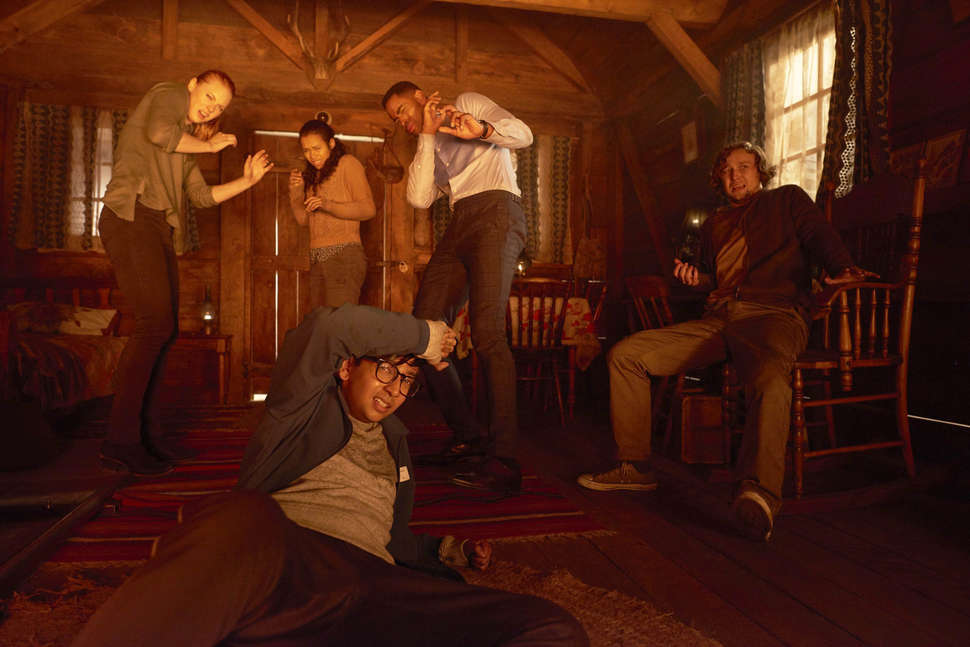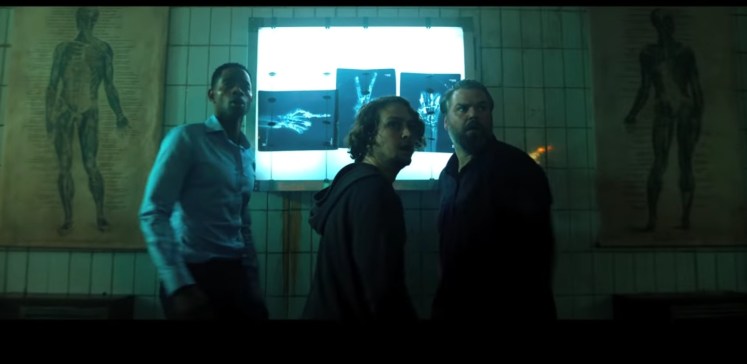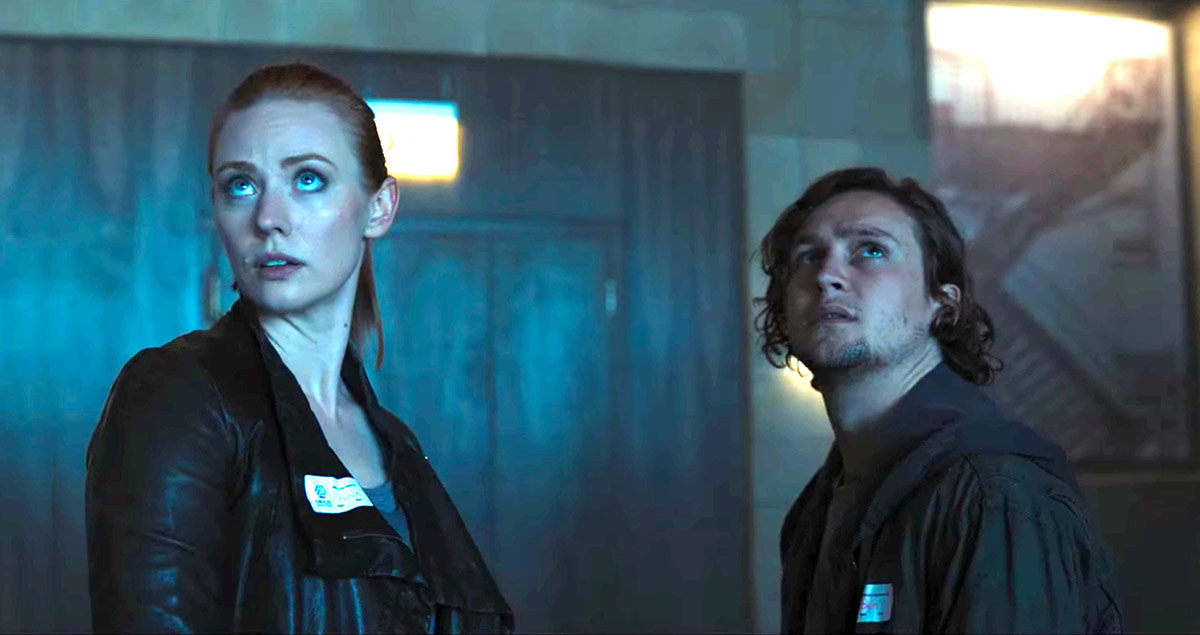
It’s been a very Guillermo Halloween for me this year, as I watched Crimson Peak for the first time, and have just finished Cabinet of Curiosities (both available on Netflix right now, if you too are so inclined to have a very Guillermo (extended) Halloween (as this review is coming out after Halloween, but c’mon–we can enjoy spooks all year round!)).
So how is the Cabinet?
It’s part strange, part horrifying, part mesmerizing, and all absolutely wonderful. In other words, it’s everything a cabinet of curiosities should be.

General Things
Like del Toro himself explains in the prologue of the first episode, the “cabinets” that the series takes its name from were actually collections of objects that largely originated in the 16th century (though some did exist prior to this–you know, before cabinets were cool). Often they were actually a room of curious items, rather than a cabinet or box (or the funky contraption del Toro uses in the prologue of every episode to introduce the piece).
In many ways, the cabinets were museums–celebrations of the weird and unusual in science and art. Famously, though, some of the objects were faked, such as “mermaids” or other creatures with human skulls and torsos attached for the sake of shock value (or maybe they were real–who’s to say?). At their heart, the cabinets were, as the name suggests, a celebration of our natural curiosity for the world around us and everything in it.
Although the term has been coined in recent years to represent more horrific and fantastical objects rather than a celebration of the wonders of the natural world as is, well…who are we to argue how those two sides can be connected? Is it not horrifying that many species will eat the heads of their mate? Is it not eerie that there are carnivorous plants? Is it not unsettling that more than 80% of the ocean remains unexplored by us?
The point, I suppose, is that while this Cabinet of Curiosities is, at its core, a horror anthology, it does fit in beautifully with the original purpose of those initial cabinets–to celebrate and put on display the weird, the unusual, the strange, the unsettling, and yes, maybe even the real of the world around us.
Every episode is introduced by del Toro himself, as he unlocks a new section or opens a new door of a mysterious cabinet-esque contraption, laying out for us an object that ties in to the story we are about to enjoy, as well as a figurine of the director for each piece. I’ll discuss each episode in both a spoiler-free and spoiler-filled light, just in case you’d like to experience the Cabinet for yourself without fully knowing what lies in wait.
Episode 1: “Lot 36” directed by Guillermo Navarro

SPOILER-FREE SUMMARY AND NOTES:
Set in the 90’s, we follow military veteran and white supremacist Nick on his journey to get some super friendly debt collectors off his back. To get money, Nick buys storage units and sells whatever he can find inside that’s worth something (at least to him). Everything changes the day he buys lot 36 and attempts to get a price check for a unique occult table and set of books he finds inside.
Potential scare warnings include Nick being a racist asshole, an unsettling shot of an animal skull early on, and a demon tentacle monster doing demon tentacle monster things.
SPOILER-FILLED ENDING DESCRIPTION AND NOTES:
Early on in the episode, we’re introduced to a very sweet house cleaner named Emilia. Due to a miscommunication, the manager of the storage building accidentally sold her unit to–you guessed it–Nick. Emilia pleads with Nick to get her stuff back, especially sentimental stuff that would have no value to him, but Nick refuses, throwing in a bunch of racist insults and slurs for good measure. Out of the “goodness” in his heart, he does give her the padlock to her old unit. Gee. Thanks.
(This will literally come back to bite him later)
After trying to get a price check for a wooden table he finds in lot 36, Nick is introduced to Roland, who offers a mighty sum for the table and the books found within. If Nick is able to find the elusive fourth volume, the money Roland will pay will absolutely cover Nick’s debts and then some. Nick and Roland head back to the storage lot, determined to chase down the fourth volume. Along the way, we learn with them that the owner of lot 36 made weapons for the Nazis during WWII–a kindred spirit, Nick!
We also learn why the fourth volume is so rare–the books are used to summon a demon, and the fourth volume actually burns to a crisp upon completion of the transaction and pact with said demon. Nick, of course, doesn’t believe any of this and just wants to find the fourth book so he can get paid.
Back in the unit, Roland uncovers a series of newspapers asking what happened to a socialite named Dotty, who apparently disappeared without a trace back in the 40’s. After Nick and Roland discover a false wall in the unit, they enter a cave that smells just super awesome. Following the cave, they enter a room where a mostly mummified body is laid out on a pentagram, intact except for the face, which is nothing but a large opening with some peeks of tentacles every now and then. In the back corner of the room, the elusive fourth volume sits on a stand, decidedly not burned to a crisp. Roland determines that this is in fact the missing Dotty they have just discovered–left to rot left to rot over the years and trap the demon inside her.
Nick, still money-obsessed, breaks the pentagram on the floor in his rush to the back of the room to grab the book. This, of course, was a bad idea, and the demon rises, chomping up Roland. The book burns in Nick’s hands, signalling that the contract has been completed with Roland’s death, but now Nick has a new problem–the demon is loose and doesn’t seem to be all that keen on letting Nick out alive. Nick runs, racing through the storage lot, desperate to find a way out. When he does finally find a door, it’s been locked from the outside.
Who should show up then but Emilia! Nick begs her to open the door and let him out, but instead, she holds up the padlock he had given her earlier. While Nick pleads, she simply places the padlock over the door and walks away, leaving Nick to a tentacly demise. Tentacle-y? Tentacley?
It’s an ending very reminiscent of the “My House” mug shot in Knives Out, which I like. It’s a quick and satisfying little comeuppance story, and while I appreciate the use of mercy in stories and I think there’s a world in which a story like this could be told where the Emilia character does help Nick, it was made very clear throughout that Nick would likely never change. Emilia could help him and he’d still yell at her for “not speaking his language in his country” or whatever. Horror is hard to stomach when a character we love dies–but it can also be a liiiiiittle bit therapeutic when a character like Nick gets what’s coming to them. There’s even a really nice scene where Nick argues with Eddie, the owner of the storage lot, about Nick’s time in the military. Nick complains about how he served his time and his country and so on and so forth and Eddie asks if he happened to notice how many black and brown bodies he stepped on in order to get back home. The story doesn’t make light of Nick’s service, but it does make clear that he’s still incredibly privileged and his status does not excuse his horrific behavior. Tentacle demons don’t discriminate when it comes to their meals, after all.
All in all, I really liked this one. I was left with a couple questions at the end as far as like, the identity of the original owner of lot 36 and why Roland seemed so knowledgeable, but I would also be willing to believe that I missed some things while watching it. It’s also entirely possible that details like that aren’t crucial to the overall story. Still, I’m detail-oriented.
The soundtrack by Tim Davies is incredible and as is true with any del Toro production, the monster effects were simply *chef’s kiss*.
Episode 2: “Graveyard Rats” directed by Vincenzo Natali

SPOILER-FREE SUMMARY AND NOTES:
For this story, we follow a graveyard caretaker named Masson. Though we initially meet him through a scene where he scares off and subsequently shames a couple of graverobbers, moments later we find out that Masson is a bit of a graverobber himself, though his specialty is ripping out gold fillings from the corpses and making money off of them. He drops this initial tooth, however, and when he goes to retrieve it, he’s bitten by a rat. He later tells the individual he usually sells to that he’s more behind than normal because of all the rats doing a bit of their own graverobbing. Desperate after being told he has to settle his debts soon or else, Masson visits a friend of his in the morgue (who is also in on the scheme). Masson learns of a recently deceased rich man whose mouth is FULL of gold fillings, but the morgue employee, Dooley, warns him to wait until after the funeral so the coroner doesn’t start asking questions. So Masson waits, choosing to go after the fillings after the funeral, but it’s a costly choice–there’s more to these graveyard rats than meets the eye.
Potential scare warnings include a whole lotta dead people, a whole lotta rats, skeleton monsters, rat monsters, and a LOT of claustrophobia. If any episodes of The Magnus Archives involving the Buried were ones you skipped, this episode will probably not be your cup of tea.
SPOILER-FILLED ENDING DESCRIPTION AND NOTES:
When our buddy Masson opens the coffin to retrieve his gold filling payday, he’s shocked to see that the coffin is…empty? Yep–turns out the rats are actually stealing the entire damn body. Horrified both by this revelation and by what awaits him if he’s unable to pay off his debts, Masson somewhat overcomes his own claustrophobia and dives into the hole after the body and the rats. After fighting off a huge number of rats and surviving a rockfall, Masson awakens in some sort of underground tunnel system. The peace only lasts so long, as Masson catches sight of a massive hairless rat further down the tunnel, curled around other rats as if she’s feeding them. This queen rat seemingly disappears moments later, however…only to reappear and chase Masson further through the tunnels.
After narrowly escaping her, Masson ends up in a massive cavern filled with a wholeeeee lotta human bones. Initially panicked, Masson tries to escape, before a thought occurs to him…this is a whole lotta bodies with potentially a whole lotta gold fillings ripe for the taking. Now celebrating his luck, Masson moves deeper into the cavern, uncovering a number of riches as well as a fair amount of strange carvings on the wall with some sort of eerie creature depicted in them. Then, Masson stumbles upon a slightly more well-preserved corpse sporting a really nifty (and probably pricey) golden necklace. Thrilled, he rushes up to the corpse and, after some struggling, manages to snatch the necklace.
This, of course, kind of upsets the corpse (I mean, how would you feel if some random dude walked up to you and snatched your necklace?), who comes to life and starts chasing Masson through the caves and tunnels, screeching “MIIIIINE!” all the way. Masson runs, and just when he thinks he’s escaped the corpse, he finds the rat queen again. He manages to defeat her, but the angry corpse is still after him, so there’s no time to sit around and enjoy his victory. Masson is utterly lost however and starts choosing tunnels at random, hoping somehow he can find his way back to the surface.
Just when all seems lost, he spots light at the end of one of the tunnels. Grateful, Masson crawls towards it, relieved, only to discover it’s not outside light at all–it is in fact the reflection of his lantern light on the plaque on the inside of a coffin lid. Unfortunately, he doesn’t even get a chance to wallow in his misery, as he is promptly swarmed with rats and completely stuck with nowhere to go.
We see Masson again when the two graverobbers from the very beginning, having learned nothing, open the casket and recognize the caretaker. Before they can do anything, a rat emerges from Masson’s mouth, and as the graverobbers scatter, Masson is once again swarmed with rats. Rest in peace, my guy.
I liked this one a lot! Sure, I was left with questions about the underground area, but it was presented in such a way that while we never learned specifics, there were enough tropes to rely on that we figured it out. The rats, and the queen rat in particular, were clearly connected to the carving Masson found underground as well as the corpse with the necklace. Taking the ancient necklace was, obviously, a bad idea. We may not know exactly how the underground area came to be the way it was when Masson found it, but we don’t have to understand that to enjoy the episode. I think it would be a fascinating idea for a full-length film, but it works nicely as is.
The score by Jeff Danna is fantastic for setting up the general unease and creepy crawly atmosphere. Also, naming one of the tracks “The Ascent to Hell” (when we’re all so used to referring to something as a descent to hell) is just incredible.
What did we learn from this one, kids? “Don’t do graverobbing if the rats in your area already staked their claim. Also, don’t steal ancient gold necklaces from corpses. That’s just rude.”
Episode 3: “The Autopsy” directed by David Prior

SPOILER-FREE SUMMARY AND NOTES:
For this story, we follow a Dr. Winters, brought in by a friend to perform several autopsies in the aftermath of a strange and terrible incident. Winters’s friend Sheriff Craven explains the circumstances behind the incident when the two meet up–it’s a strange case of seemingly unconnected events that all led to one particular miner, a man named Joe Allen, using a strange device to set off an explosion, killing himself and several other miners in the process. What starts off as a routine albeit unusual autopsy turns into something far more sinister and surprising by the end of the night.
Potential scare warnings include, once again, a whole lotta dead people, as well as lots of organs and such (it is called The Autopsy for a reason, after all). There’s also the aforementioned explosion, some stabbing and slicing, and some tentacles (though not nearly as many as Lot 36, so there’s that).
SPOILER-FILLED ENDING DESCRIPTION AND NOTES:
While the main meat of the episode (ew, wrong choice of words for this subject matter, my bad) is the titular autopsy, there is a fair amount of time taken to focus on the events leading up to the explosion, that then leads up to the autopsy itself. While Craven goes into detail about the miner who caused the explosion, Allen, discussing how he apparently hadn’t seemed like himself lately, as well as about some dissected human remains the department had recently found in large black bags, Winters takes a moment to divulge that he has been diagnosed with terminal cancer, having a few months to live at the most (this seems like an odd, sad detail in the moment but it does come into play later).
Perhaps the oddest thing about the whole incident, Craven explains, is that at one point, the police were actually in possession of the strange object Allen used in the explosion. Once they’d caught up with him, he had a moment where he could have run–instead, he grabbed the device and headed into the mine, blowing everything (and everyone) up. When Craven then asks if Winters would like him to stick around to keep him company during the autopsies, Winters tells him to head on home and get some sleep (this is, as you may imagine, a poor and unfortunate decision on his part). Now alone with the bodies, Winters starts a recorder to explain his findings to Craven as he carries on, and gets to autopsy-ing.
Though there are some odd details about some of the bodies, there doesn’t seem to be anything incredibly noteworthy, at least at the start. Winters makes note of some strange details as he carries on, but nothing can fully prepare him for the truth, which is….
ALIENS.
(oh, snap)
Yes, that’s right, the reason Allen had been acting so strange lately is because he was actually possessed by an alien parasite creature thing. With tentacles. The thing reanimates the supposedly dead Allen, knocking Winters out. When he comes to, he is strapped to one of the autopsy tables, which is when Alien Allen gets to monologuing about how in its true form, it’s weak in that it is essentially “senseless”–without any sensory organs of its own, it relishes finding hosts to inhabit and using their bodies to experience things, all while feeding off it from the inside. Alien Allen is suuuuuper excited about Winters, specifically because of his cancer. Alien Allen explains that it will essentially fuse minds with Winters, taking the cancer away because it will be feeding off of it, and doesn’t Winters want the cancer to be gone?
While Alien Allen begins splicing up Allen’s body to free the parasite self so it can then slide on into Winters, Winters desperately tries to think of a way to stop the creature, disgusted by the way it enjoys the pain of those it inhabits. As the real Allen dies with the parasite exiting him, he manages to offer the scalpel to Winters, at which point Winters understands everything: Allen caused the explosion because he knew about the parasite, and was trying to get rid of it. And now, with the gift of the scalpel, Winters can do what Allen couldn’t.
While the parasite slowly works its way over to Winters, the doctor gets to work. Stabbing his eardrums with the scalpel, and apparently gouging out his own eyes (I don’t remember that part specifically though it apparently happened, guess I blocked it out…I mean, can you blame me) Winters writes something on his chest in blood before finally slitting his own throat. We then cut to a sort of mystical-looking background, where Winters explains to the parasite through their now shared consciousness that it is now trapped in Winters’s dying and now disabled body–the parasite can’t use many of Winters’s sensory organs for its enjoyment because of how he mutilated them himself. Not only that, but Craven should be showing up soon, and Winters had left his recording on.
Craven does show up, crushed at the state his friend is in, but sees what Winters wrote on his chest with his last moments: instructions to play the recording and burn his body (and the parasite).
This one was devastating to be put through, but I did love it. Part of that is the impeccable acting put out by our leads (F. Murray Abraham, Glynn Turman, and Luke Roberts) but part of it is just how incredibly written and directed this piece is–everything is tied up neatly at the end, and the horror doesn’t win, ya know? Winters’s fate is horrendous, but he’s such a clever and likable character in just the hour or so that we know him, it would be doing him a huge disservice if he had ultimately been unable to take the parasite down with him.
Imagery that will absolutely stay with me forever is the way they cut between Winters performing the autopsies and Allen’s dead hand hanging off the table in the back room multiple times before revealing Allen had been reanimated. We’re used to that shot, where the hand hanging off the edge of the table suddenly twitches or moves, but they don’t play that card immediately and I love them for it. The suspense built up plays directly off of our expectations, and it works so, so well.
The score by Christopher Young is impeccable, and it adds so much in the terms of uncomfy vibes to the story as we learn what really went down.
(To be really nerdy for a second: the first piece featured in the episode, fittingly called “The Autopsy,” is almost…pleasant. It’s played before we know what’s actually happening, but while it isn’t outright scary like the other two pieces Young composed for the episode, something about it still seems…off. It reminds me a lot of the music he composed for the remake of Pet Sematary (my review of which can be found here!) because you would have songs like “Fielding Fine” which are genuinely lovely and nice, and then you’d have…the rest of them. I just think it’s a fascinating thing Young does in the things he composes for.
Anyway. Extra nerdy moment done for now.
But extra sidenote–revisiting my Pet Sematary review now is kinda funny because I make it VERY CLEAR I am no horror aficionado there…and now here I am, a few years later, purposefully watching and reviewing horror stuff because I enjoy it. I still wouldn’t classify myself as an aficionado for this kind of thing, but I do have a newfound appreciation for horror and what it is and can be.
Still don’t like the direction they took Pet Sematary in, though.)
Episode 4: “The Outside” directed by Ana Lily Amirpour

SPOILER-FREE SUMMARY AND NOTES:
Welcome to our next story, where we follow a bank teller named Stacey. Stacey is a bit quirky. Though Stacey seems to have a perfectly delightful little life–nice job, nice husband, nice house, etc., she’s convinced that she’s stuck on the “outside,” particularly when it comes to the other women at work. They all look and act a certain way, and Stacey just doesn’t fit in with all that. Also she does taxidermy. So I mean. There’s that.
Everything changes, however, when Stacey gets invited to a Secret Santa party with her coworkers. She and the other women all receive a special kind of lotion called “Alo Glo” which is apparently all the rage and will fix everything wrong in your life, as lotion does. But because you just gotta kick a girl when she’s down, Stacey seems to be allergic to the magical Alo Glo and returns home with a nasty rash. If you thought all seemed to be lost for Stacey, however, fear not–everything’s about to change. So actually, maybe you should fear…
Potential scare warnings include taxidermy and the process of making it, lots of skin stuff because of Stacey’s rash, stabbing, blood, and if you’re more sound-sensitive, lots and lots of squelchy noises because of the lotion.
SPOILER-FILLED ENDING DESCRIPTION AND NOTES:
So the fun really begins when Stacey is watching TV one night after the Secret Santa party (it was actually a fake Secret Santa party, because it was really just one of Stacey’s coworkers giving everyone Alo Glo samples a la one of those mlm product parties. Stacey was the only one who brought a separate gift apparently, and her coworker didn’t really appreciate the taxidermy duck Stacey made. Weird.). She’s miserable, having called out of work due to the rash.
At this point, the man in the Alo Glo ad starts talking to her directly. He is able to convince Stacey that she’s not allergic to the lotion, and it does have the power to make her beautiful and change her life, this ugly and unhealthy rash is just part of the process, that’s all! It just means it’s working! Doesn’t she want to be beautiful? Doesn’t she want to fit in with her coworkers?
This completely convinces Stacey, and she orders a giant box full of Alo Glo. For the next several days, Stacey continues to stay home from work and slather herself in Alo Glo and her rash gets worse and worse and worse. Her husband begs her to stop using the stuff, saying she should see a doctor, but Stacey is delirious with the promise of “beauty” and is utterly convinced the lotion is working, it’s just a long process. Her husband isn’t convinced. He tries to tell her that she’s perfect and wonderful the way she is, and doesn’t she hate those women at work anyways? Why would she want to be like them? He loves her just the way she is, but Stacey doesn’t care.
At this point, all of the bottles of Alo Glo in the box she ordered suddenly open and the lotion starts pouring out of the bottles, filling the box and spilling over the edge. By the time Stacey gets to the box, the spilled lotion has formed into a humanoid figure, reaching out to her. Stacey embraces the lotion person, drenching herself in the stuff in the process. When she re-emerges, her husband is horrified to see her in this state and makes the decision to call a doctor for her. Frustrated that her husband refuses to “support her” and in a moment of pure anger, Stacey ends up stabbing her husband in the forehead. There’s a long and awful moment where her husband is bleeding, desperately trying to reach out on his police radio for help, but it’s too late–Stacey finishes the job with a hatchet.
The lotion person returns, heading up to the bathroom where it then dissolves into the bathtub, filling it. Stacey sinks into the tub, coating herself with Alo Glo (not unlike how the lotion person looked originally). When she emerges, squelching her way into the bedroom, she notices that sections of the lotion are peeling off–everywhere she pulls the lotion off, her skin is revealed to be smooth and perfect, with the rash nowhere to be seen. By the end, she is, at least in her eyes, beautiful. Thrilled, she runs downstairs to show off her new self to her husband…’s corpse.
In a terrific mood, Stacey goes on to taxidermy her husband, throw on some fancy clothes and makeup, and for the first time since the day of the Secret Santa party, head off to work. While her coworkers are shocked to see her initially, they quickly warm up to her, bringing her into their little gossip gaggle. As Stacey laughs along with them, the camera zeroes in on her, until she’s looking and laughing right at us. She’s no longer on the outside–we are.
Look, all of these episodes are unsettling in some way, but this is the one that sticks with me the most. I think it’s phenomenal and also I hate it so much. It’s so uncomfy!! I haven’t been able to stop thinking about it!! But I love the way it turns beauty norms and even the beauty industry itself into a really effective horror story. I hate it. But I also love it. I could go on and on about how incredible the presentation of the superficial coworkers was, and how while we didn’t want to Stacey to want to be like and fit in with them, we understand how she feels, though! It works so well as a story because it’s so easy to see the Stacey in ourselves–it’s an incredibly human thing to want to belong, and to feel like you’re on the outside of something special that other people have.
I think the part that really kills me (no pun intended) is how genuinely good Stacey’s husband was. You get the impression they had a really good marriage and good relationship, and he was truly worried about her–he didn’t even really try to intervene himself until he thought that Stacey’s health might be in danger. Despite her claims that he wasn’t supporting her, he really did try to! He did try to give her space to figure out what she wanted! In the end though, the predatory beauty culture wins out, and Stacey not only murders him, but what we can assume to be the only truly good relationship she had, all so she could fit in with the popular kids. It’s such an eerie and gorgeous commentary on this particular section of modern society, and it’s chilling.
RIP Stacey’s husband–perfect cinnamon roll too good for this world, too pure.
And, of course, Daniele Luppi’s work on the score is phenomenal. It’s super eerie and uncomfy. I hate it. So it fits in perfectly with the episode.
Remember kids, if late night infomercials start talking directly to you, it’s time to turn off the TV and go straight to bed (do not pass “Go,” do not collect $200). Yes, even if the one speaking in the ad looks and sounds like Dan Stevens.
(Sidenote–this episode is based on a webcomic by Emily Carroll which you can check out here if you’re interested! I might do a whole separate post detailing the similarities and differences between the episode and the webcomic because, as previously stated, it is this episode that sticks with me the most out of the bunch and I may never be satisfied talking about it enough)
Episode 5: “Pickman’s Model” directed by Keith Thomas

SPOILER-FREE SUMMARY AND NOTES:
Welcome to the early 1900’s! Our protagonist for this story is an art student named William Thurber. Thurber is your typical pretty boy teacher’s pet, complete with lovely girlfriend and a rowdy group of art student buddies. But who cares? No big deal…he wants mooooooooore!
(He wants to be where the monsters are…he wants to see, wants to see them killing!
…*ahem* anyway)
This becomes evident when Thurber becomes absolutely fascinated with new student Richard Pickman. In a realism class where the students are supposed to be drawing what they see, Thurber gets a glimpse of Pickman’s drawing and sees something absolutely horrendous and spooky, though not necessarily realism. Intrigued, Thurber sort of adopts Pickman, encouraging him and asking him where he gets the ideas for his incredibly monstrous and unsettling work. Pickman himself seems to be a sort of foil for Thurber, appearing shy and awkward in comparison to Thurber’s confidence and charming personality.
This friendship is cut short, however, when Thurber starts seeing creatures from Pickman’s art in the real world. When the effect it has on him almost ruins his chances with his girlfriend, Thurber decides he’s had enough.
Years later, Thurber is still having dreams about Pickman’s paintings, but he has, for the most part, seemingly moved on with his life. That is, until Pickman himself reappears, setting into motion a horrific sequence of events that, despite all his efforts, Thurber is unable to avoid or change.
Potential scare warnings include really unsettling and scary paintings (no…really), lots of monsters, blood, and um…cannibalism? They don’t show the actual act, but rather what leads up to it, so it’s heavily implied.
SPOILER-FILLED ENDING DESCRIPTION AND NOTES:
As you might imagine, Thurber is none too thrilled when Pickman waltzes back into his life years later. He drops off a painting of his as a gift, and Thurber discovers this far too late–his son, James, has seen the painting and now is having awful nightmares. Now this feels personal, and Thurber confronts Pickman, who genuinely doesn’t seem to understand why Thurber is so unhinged about all of this.
(It’s worth noting, also, that nobody else seems to have the same reactions to Pickman’s paintings that Thurber does. Sure, James starts having nightmares, but no one else seems as disgusted and horrified by the art as Thurber is. In fact, when Thurber brings up not allowing Pickman to have a place in a gallery show or not wanting him to even be around anyone else, everyone honestly just chastises Thurber for being rude to poor Pickman. C’mon, Thurber, that’s not very nice of you.)
Pickman finally convinces Thurber to come to his home, to his studio, to see the art. All Pickman wants, he claims, is for the work to be seen. Thurber, itching for this nightmare to end, agrees. Pickman’s studio is just as eerie and unsettling as you would expect, and of course, driven mad by everything so far and his own frustration, Thurber makes a horrible decision and ends up shooting Pickman, killing him. Maybe on accident? Regardless, it’s not great. Thurber then sets fire to all of Pickman’s art, determined to see the nightmare end once and for all, but he’s shocked to see one of the monsters from Pickman’s work appear, dragging Pickman’s body off and presumably eating him. Thurber can’t spend too much time thinking on that, however, and seems to convince himself that everything, including the real monsters, will burn with the art, closing the book on that story for good.
Thurber takes his wife and son to see the gallery show he put on, sending them off to explore while he meets with one of his friends. Sadly, the good feeling doesn’t last long, as Thurber realizes that many of the works on the walls are in fact Pickman’s. Not only that, they’re pieces that Thurber remembers burning that one night. When he goes to ask his friend what the hell is going on, he’s horrified to see his friend has been staring at one of the pieces in a trance, the left side of his head completely mangled while he mutters about something.
Realizing what this could mean, Thurber rushes off to find his family, but it’s too late–they’ve seen the paintings. Thurber rushes them home, ordering one of the gallery workers to take down all of Pickman’s works and destroy them. With that done, Thurber himself heads home. His wife is facing away from him, steadily chopping something. Thurber tiredly apologizes to her, explaining that it’s all over now, and everything’s fine.
As you can probably guess, everything is not fine.
When his wife turns around, we and Thurber are met with the horrific sight and knowledge that she has gouged her own eyes out. Pickman’s paintings have driven her mad, and she is speaking strangely (I mean…you probably would be, too).
(Also, we never see what it is exactly she was chopping up, but the sound effects imply…yeah.)
Remembering one of Pickman’s works in particular, and extremely unsettled, Thurber asks where their son is. His wife simply smiles, and Thurber opens the oven to find…yeah. Just like one of Pickman’s paintings, his wife gouged out her own eyes, and then proceeded to murder and roast their son. Aaaaaand then the episode ends so we have no idea how Thurber deals with this particular roadblock…
Though not one of my favorites, I did enjoy this one, particularly the tragedy of it all. There’s something about the way that Thurber only realizes Pickman’s paintings do depict reality and even the future when it’s just slightly too late–he ends up losing whatever friendship he might have had with Pickman as well as his wife and son. Even Pickman thought they were friends, and tells him as much, and it just breaks my little heart–the story does a fascinating flip from hinting that Pickman, with his strange mannerisms and eerie paintings, must be the villain, to showing that it was never him but the monsters themselves and even Thurber. All Pickman wanted was someone who understood and saw beauty in his work, and Thurber shuts all of that down so he can have a normal life. That choice, however, then leads to him losing absolutely everything.
(This isn’t even touching on the potential queer undertones here–Pickman being “the odd one out,” no one understands him, Thurber reaches out and forms a friendship because he’s drawn to him (HE GIVES HIM A NICKNAME EVEN), but ultimately he chooses societal norms over it all and ends up marrying his girlfriend and having a family with her, shunning Pickman even when he comes back into his life, even when Pickman assumes they’re still friends…IT’S JUST. YES.)
At the end of it, all Pickman wanted was someone who understood and could see the world the way he did. He just wanted someone to share that with. When he brings Thurber to his studio, I don’t think it’s with malicious intent, I truly think he assumes that once Thurber sees the truth, he’ll understand. They’ll be in this together.
But Thurber doesn’t give him the chance. Pickman dies. The monsters are real. His wife goes mad. Children get tossed into ovens. You get the idea.
The score by Michael Yezerski is–you guessed it–amazing. It’s a beautiful blend of sweeping and lovely to set the scene when things are “good” and incredibly eerie and haunting for when the more horrific things happen.
All in all, it’s a great entry into the “Ben Barnes has his life ruined by cursed paintings” cinematic universe.
Episode 6: “Dreams in the Witch House” directed by Catherine Hardwicke

SPOILER-FREE SUMMARY AND NOTES:
Welcome back to the early 1900’s!
(Yes, we’re still here–this was the Lovecraft section of the cabinet)
For this tale, we follow a man named Walter Gilman on his supernatural quest to save his sister’s soul. When he was a kid, Walter’s twin sister Epperley died, and he witnessed her spirit get dragged away into a forest. Years later, he’s now working for a sort of paranormal investigation society, searching high and low for some way to bring his sister back ~from the beyond~. So far, nothing has worked.
As the people in his life begin to lose patience with him and his obsession with doing the impossible, Walter finally stumbles upon something that almost gives him exactly what he wants. The downside? Epperley’s spirit isn’t the only one out there hoping to get back.
Potential scare warnings include some light creature jumpscares, I think some stabbing, something very similar to that famous scene from the movie Alien, some dead bodies, and some very unsettling critters.
SPOILER-FILLED ENDING DESCRIPTION AND NOTES:
So basically, as is to be expected, Walter must first deal with a sort of “fall from grace” kind of deal before he’s able to reunite with his sister in any form. His best friend and coworker at the supernatural society basically quits so he can get a better paying job, Walter himself is let go from the society and disgraced, and he loses his original place of residence. He has a plan though!
Walter rents a room in this deeeefinitely not haunted house which apparently used to belong to a witch who was executed, named Keziah Mason. He also starts frequenting this uh…bar? Smoking room? Local cool kid hangout? where he takes an Indigenous drug that allows him to actually venture into the Forest of Lost Souls, which is where Epperley was dragged off to when they were kids. He’s able to find her, but he can’t ever stay in the Forest for long–plus, something has detected his presence there.
(It’s Keziah, it’s the witch lady…I mean it’s called Dreams in the Witch House we were bound to reach this point some time)
After one of his visits, however, he finds that he was actually able to take a torn piece of Epperley’s sleeve back with him to the real world, which convinces him that it is possible to bring his whole sister back with him. By this point he has also befriended another tenant of the witch house, a fellow disgraced individual who believes that Keziah is still out there somewhere, doing her best to return to the real world.
Despite everyone’s warnings, Walter stays focused, learning that the reason he was able to bring Epperley’s sleeve back and the reason he’s able to cross the threshold and find her so easily is because he and Epperley have their own kind of magic: they’re twins. Twins are the key! Determined and confident, Walter ventures into the Forest once more. Unfortunately, he and Epperley are somewhat stuck now because Keziah knows what they’re up to and wants to use them to return herself. Just when they think they’ve outmaneuvered her, however, their position is given away by–and I wish I was joking–a talking human-faced rat.
Walter and Epperley do escape, but they have been followed. They seek refuge in a church, which Keziah at least temporarily cannot enter, and they call on Walter’s old buddy from the supernatural society (who, for his credit, believes Walter now. That’s nice). Shenanigans ensue, and they end up back at the witch house. The new ultimatum, they learn, is that Walter has to die before dawn in order for either Keziah or human-rat to come back permanently. Just when all seems lost and Keziah has Walter pinned, Epperley comes through and destroys her. This action, however, has a price–having saved her brother and escaped from the Forest, Epperley’s spirit is free and she’s able to move on. Walter is, seemingly, alone again.
Meanwhile, the other witch house tenant and Walter’s buddy uncover a dark secret in the house: the body of both Keziah and the human-rat, who turns out to be her familiar, Jenkins.
(Fun fact! The body they use for Jenkins literally looks like a rat skeleton with a human skull on top, most likely a reference to the ways freak shows and cabinets of curiosities would actually meld skeletons in order to sell the “truth” of the existence of hybrid creatures, like mermaids. Very fun! I mean, horrific and unsettling in context, but fun!)
Speaking of rat-boy, guess who hitched a ride out of the Forest? Jenkins is here and he’s pissed at Walter for messing up their plans. He actually BURSTS out of Walter’s chest, a la Alien, and kills him, right before dawn, thereby possessing him. Now in control of a full human body, Jenkins/Walter heads out into the streets, excited to try out this body and all it can do.
(So, yes, out of context spoilers for this episode include, weirdly enough…Ratatouille.)
I walked away from this episode with a lot of mixed feelings and thoughts, but primarily…what?
The more I thought about it, though, the more I was able to settle on thinking how much I really enjoyed this one. It’s absolutely weird, don’t get me wrong, but I think that’s kind of its charm. I think it was smart to pair this story with Pickman’s Model (in terms of when the episode was released) because Pickman’s is so, so dark and bleak and just…yeah. It’s good, it’s just rough. This one isn’t necessarily any happier, of course, but the absolute strange and quirky nature of it was just…I like it. I have yet to hear of anyone else feeling this way, but that’s fine–maybe this one was made for me and me only.
The whole thing also literally comes full circle, because they actually start the episode with a shot of Walter’s body and you hear Jenkin’s voice talking as if it’s him–and by the end, it is! He even sets it up the way Flynn does in Tangled (“this…is the story of how I died…”) and you aaaaalmost forget about that by the time you actually hear both Walter and Jenkins speak. It’s built up in such a way, even, that you think maybe the protagonists won! Alas…it’s another victory for the cursed rats.
(What is it with this anthology and cursed rats?)
I don’t know–something about it feels a lot more fantastical than some of the other entries, and I think that’s cool? But I can see where, coming out of Pickman’s Model, this one feels a bit too out there. Horror can be quirky and weird, too, you guys–that’s one of the beautiful things about the genre as a whole.
As always, the soundtrack for this one, composed by Anne Chmelewsky, fits the vibe perfectly and I love it.
Episode 7: “The Viewing” directed by Panos Cosmatos

SPOILER-FREE SUMMARY AND NOTES:
WELCOME TO THE 1970’S!! In this story, we follow a rather unusual group of individuals who are summoned to an eclectic rich guy’s mansion for “a special viewing.” On the way over, they do their best to try and figure out what a musician, a physicist, an author, and a psychic all have in common (yes, it does sound like the setup for a bad joke). Upon their arrival, they meet both the rich guy himself and his physician and, after a whole lot of drugs to “expand their consciousness” and “get them on the same wavelength,” the viewing commences.
As you might expect, things go horribly, horribly wrong
Potential scare warnings include just a whole lot of drug use, people making a lot of really dumb decisions, and lots of face/body melting. Like, lots.
SPOILER-FILLED ENDING DESCRIPTION AND NOTES:
Honestly like, 80% of this one is the quirky cast of characters doing drugs and talking about life, so we can skim through that beginning section. Basically, our cast includes:
- Eccentric old rich guy Lionel Lassiter who has very strange decorating taste, among other things
- His physician Dr. Zahra who I’m sure is extremely smart and capable but also her primary treatment plan seems to be cocaine, which I mean…ya know
- Local musician who’s lost his mojo until he starts smoking, Randall Roth
- Local physicist who believes in ~aliens~, Charlotte Xie
- Local author who’s also, let’s face it, kind of a jerk, Guy Landon
- Local ~quirky~ psychic, Targ Reinhhard
- (There’s also Lionel’s assistant? Employee? Driver who brings the others to the rich guy house? He’s also there, at least sort of)
And Lionel and Zahra spend most of the time just convincing the others to drink and do drugs (you could totally do a “this is your brain on drugs” ad with the footage of melted faces once we get to that point) and literally the only reason I’m unsure why this is so necessary comes later when it like…directly leads to a lot of death.
Anyway, once everyone’s good and high, (and once Charlotte and Zahra have had lots of ~gay pining~ moments), we finally get to the actual viewing section of the story. Lionel takes everyone to a ~secret room~ where he reveals what he’s been holding on to: some sort of large, sparkly meteor thing (it’s unclear if the meteor is actually sparkly, or if that’s just how they all interpret it due to collective drug brain). They’re all intrigued, of course, and Charlotte is the most excited, being an alien physicist and all. Randall, meanwhile, continues smoking in the room, despite Lionel repeatedly asking him to stop. It is, however, too late.
The meteor seems to inhale the smoke, glittering ominously one last time before it cracks open like an egg (once again…this is your brain on drugs) and reveals that inside is some sort of orange, globby friend. The whole thing was like alien silly putty! By this point, everyone has fallen into some sort of trance, however, and this is where things get unfortunate:
Targ and Guy are the first to die, a la face melting and head exploding, respectively. Panicking, Charlotte and Randall are watching in horror and trying to find a way out of the sealed room. Still in the trance, Zahra approaches the blob and touches it–this causes her to melt. The alien ooze then makes its way over to Lionel, possessing him and kind of turning him into this orange blobby humanoid figure with horns. By this point, Lionel’s assistant/employee friend arrives, promising to give Charlotte and Randall time to escape. Assistant/employee does his best, but ultimately, he is no match for alien ooze.
Charlotte and Randall, meanwhile, hightail it out of there and make their escape in a snazzy sports car, trying to figure out if what they just witnessed actually happened. At the same time, alien ooze makes its way through the sewers, emerging just outside the city–it stalks towards the buildings, and the camera zooms out slowly, showing flickering streetlamps and probably hundreds if not thousands of unsuspecting people who have no idea how to deal with alien ooze.
While I still like this one (because I do like all of them), I will say this one is probably my least favorite of the bunch if only because it’s not my style. The questions I had at the end of this one bugged me more than some of the others–why did the meteorite react to the smoke from Randall? Why was Lionel’s assistant/driver guy completely crying in that one cut when Lionel asked him about the gold gun? Why did the trance state affect some of the attendees so strongly while it didn’t affect Charlotte and Randall strongly enough, thereby allowing them to escape? Not end of the world questions, of course, but for me personally, it left me a bit disappointed and I feel like it weakened the piece as a whole. But that’s just me, I’m sure it was a favorite episode for others and that’s awesome. I’m fully willing to believe the point of it went right over my head. Maybe it’s a commentary on how rich people’s questionable hobbies can ultimately lead to their downfall? Or maybe it’s just another entry in the timeless story of “don’t mess with aliens and turn things we don’t understand into needless spectacle”
Nope review coming to a blog near you *finger guns emoji*)
One thing I did like while trying to look up what year this one takes place–in the prologue for this episode, del Toro talks about what happens when the viewers become the viewed, which is a horrifying question and initially, made me wonder what kind of episode we were in for. This meant at the time, I didn’t see how that question related to the episode at hand. When I looked up the year for this one, however, I forgot to specify “the viewing” from this anthology and just left it as-is, which meant all the results were about the stage of a funeral referred to as “the viewing.”
This hit me like you wouldn’t believe. I’m not sure if it’s the intended connection we’re meant to make, but seeing as a key piece of this episode is us, the viewers, watching this group of people melt to their deaths…well. The ensemble of the episode thought they were attending a viewing of sorts, and they were, but the episode ropes us in as well because we are viewing them.
Then, of course, you get to wonder–who’s viewing us?
“The Viewing Suite” is the only piece of music on the soundtrack for this episode, by Daniel Lopatin. It’s definitely an unsettling, electronic vibe that fits the overall aesthetic of the episode super well. Which means that, of course, I like it.
Episode 8: “The Murmuring” directed by Jennifer Kent

SPOILER-FREE SUMMARY AND NOTES:
Welcome to the 50’s!
For this story we follow two ornithologists (bird people), Nancy and Edgar. The couple are about to take a trip to a remote island to further study a specific type of bird, a dunlin, and more specifically, why the birds move in what are called murmurations (the episode explains this beautifully, but essentially: you know when a flock of birds all move together, changing directions in a split second? How do they communicate that? How and why do they do it? That kind of thing).
Upon arrival, they are introduced to a caretaker who set up a previously abandoned house for them to stay in, rather than the tents they had planned. As the couple begin their research, it becomes increasingly clear that something else is in that house with them, and two women across history are able to share their grief amidst the call of the flocks of dunlins that inhabit the island.
Potential scare warnings include a creepy child (this is horror, after all), some light jumpscares, child death, suicide, and some like…frightening imagery I guess? The ghosts are spooky-looking.
SPOILER-FILLED ENDING DESCRIPTION AND NOTES:
The house Nancy and Edgar are told to stay in had previously been abandoned for decades, and it does show in the weathering on the exterior, but the caretaker we meet did go through and make sure it has all the basic amenities. There is a hint very early on that something tragic has happened in Nancy and Edgar’s lives, thus Edgar thinks the time away will be good for them.
While the research seems to be happening smoothly enough to begin with, Nancy starts hearing a child’s voice on the recordings she’s taken of the dunlins. She desperately wants to ignore it in the beginning, but the ghosts won’t let her. It becomes apparent that the house is home to two ghosts (at least, maybe there’s more? spoooooky) a young woman and a little boy. The boy always appears frightened and soaking wet, occasionally mentioning how his mom is angry with him, while the woman is frantic, screaming and rushing around, hair flying everywhere. You know, usual ghost stuff.
As time passes and Nancy encounters the ghosts more and more, she becomes obsessed with putting the pieces together of who they are and what happened to them. This puts a massive strain on her relationship with Edgar, as we learn that he wanted to use the trip as an opportunity to rekindle things with his wife after the loss of their daughter, Ava. Through various arguments, we learn that, at least in Edgar’s eyes, Nancy has not grieved for their daughter at all–she hasn’t even cried. After Nancy sort of forcefully asks the caretaker who the previous owners of the house were and what their story was, Edgar has had enough. Why is she more interested in a couple of strangers than her own family?
Thanks to the caretaker and some letters uncovered in Nancy’s own sleuthing, she learns that the woman’s name is Claudette–and as per true haunted house tradition, her life was filled with tragedy. Claudette was in love with a soldier, and though all seemed to be going well, it turns out he was actually married to someone else entirely and he straight up abandoned Claudette when he learned that she was pregnant with their child. Claudette was basically dropped onto the island to live alone, shunned by her family thanks to a scandal that wasn’t her fault. Like Nancy, Claudette had a fascination with the birds on the island and longed to be free like they are (something that causes Nancy to feel a sort of kinship with her, as that is always Nancy’s answer to the question of “what do you like about birds so much?”) But one night, years later, the stress and hysteria proved to be too much, and Claudette snapped, drowning her son in the bathtub.
Initially upon learning this, Nancy is furious with Claudette–I mean, who does that? So one night, when Edgar has already left to study the dunlins (and kind of made it clear that unless Nancy reached out to state otherwise, their relationship was over), Nancy decides to confront the ghosts. She speaks to the scared boy, explaining what happened to him, that his mother did a terrible thing but it isn’t his fault, and the boy runs to her, disappearing and presumably finally moving on. Now ready to confront Claudette, Nancy turns and realizes…she got the story wrong. Claudette did drown her son in a moment of intense anger, but she was wracked with so much guilt immediately afterwards that she jumped from the attic window, killing herself. Heartbroken, Nancy rushes outside to where Claudette would have fallen, but of course, nothing is there.
Instead, however, a large flock of dunlins head straight for Nancy, surrounding her in the murmuration. She spreads her arms, closes her eyes…and then she cries. Once the birds leave, Nancy calls Edgar on the radio and tells him through her tears that she’s ready to talk about Ava.
If The Outside was one of my favorite episodes from the anthology because it made me think and made me uncomfy, this one is one of my favorite episodes because it made me think and made me treasure humanity. It’s one of my favorite horror types, the Crimson Peak and The Haunting of Hill House/Bly Manor type of “it’s not a ghost story–it’s a story with ghosts in it” and “it’s not a ghost story…it’s a love story.” It’s a beautiful tragedy that focuses on relationship expectations and how we relate to the world around us.
I’ve read a couple different reviews talking about what the point of this episode is, and I love how we’ve all come away with different things. Is it a case study of how women’s grief is treated in society as a whole? Is it a commentary on family and the various things that can mean, particularly when loss comes into play?
I don’t know. I think it’s all of those things, and maybe more. We don’t know how Ava dies, or even how old she is when it happens. There’s a scene where Nancy dreams about a baby, so it’s possible that’s how old Ava was when she died, or it could just be Nancy remembering what her daughter had been like. Interestingly, we learn more about Claudette’s tragedy than Nancy’s. There’s a lot that remains unexplained, and I think that’s the beauty of it. I think there is certainly room to interpret that when Claudette died, when she fell from the window, she became those birds she loved so much (Dear Esther, anyone?). So when Nancy learns the truth and she runs outside and the murmuration encases her, it’s not a moment of horror–it’s a moment of gratitude. I think it’s very possible that being trapped in that house made Claudette forget what she had done to her son, so all she was left with was the anger. When Nancy set her son free, Claudette had to once again face what she did…and remembering that grief is what set her free also. That grief that surrounds Nancy at the end in the form of the birds is what allows her to reach out to her husband, to talk about what happened to them. Nancy has what Claudette never did: someone to share her grief with. Is that the only interpretation of the piece? I don’t think so. Grief is such a powerful human emotion, and we’ve spent centuries trying to maneuver it. This episode is just one more way of doing that.
Combined with a haunting soundtrack by Jed Kurzel, I love this piece. I think everything about it is beautifully done, and it’s definitely one I would watch again.
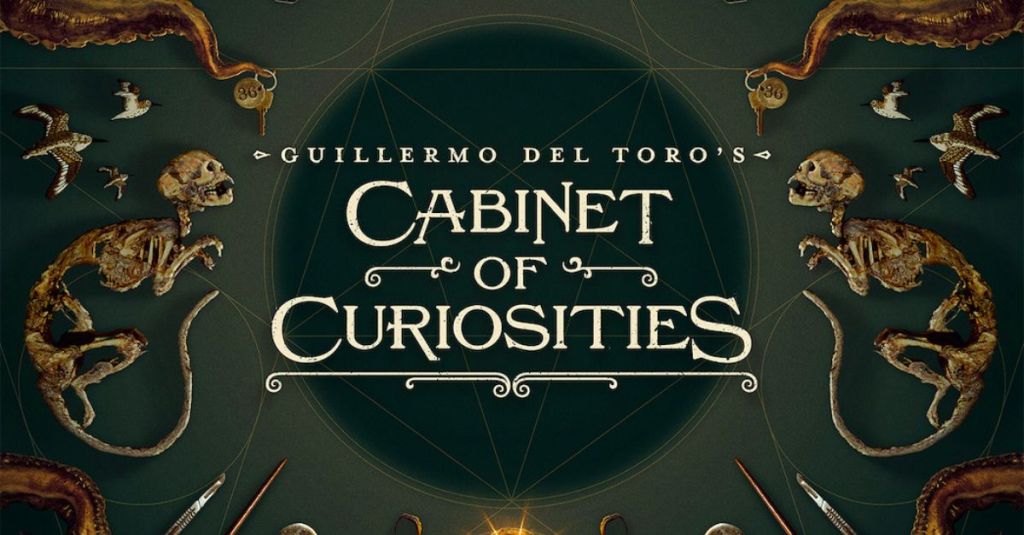
SHOULD YOU WATCH THIS ANTHOLOGY FOR YOURSELF?
YES.
If horror is of any interest to you at all, if you love Guillermo del Toro, if you love anthologies, if you love short, spooky stories…yes. I think if horror isn’t your thing, I would still think about giving it a try, but trust me–I get wanting to skip it.
All in all, it’s a beautiful collection of weird and wonderful things that showcase what it is to be human in many different ways, which, as stated before, is exactly what a cabinet of curiosities should be. If any of this sounded interesting to you, I highly recommend checking all this out for yourself.




